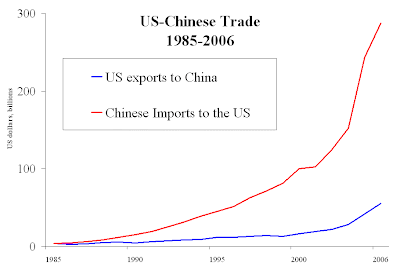 Just how unbalanced is trade between the US and China?
Just how unbalanced is trade between the US and China?
Back in 1985, bilateral US-Chinese trade was in balance. The US exported to China about as much as China exported to the US. Since then, however, the US has sucked up Chinese imports. Last year, the US imported almost $290 billion of goods, but exported just $55 billion.
Last year, the US ran up a $818 billion trade deficit. Around a third of that deficit was due to trade with China. Overall, the bilateral US-China trade deficit is running at about 2 percent of GDP a year.
So how do the Chinese manage to out-trade the US? China tightly pegs its currency's value to that of the dollar at an an extremely low rate. This low rate means that Chinese goods are very price competitive and this encourages a large bilateral surplus with the United States. This policy, in effect, offers a massive subsidy to exports. However, the Chinese need to purchase huge amounts of US assets by printing local currency. In 2006 alone, the Chinese central bank purchased around $200 billion in U.S. Treasury Bills and other securities. Currently, the Chinese are sitting on $1.2 trillion of foreign exchange reserves.
However, the Chinese can't keep on subsidizing exports in this manner. It is bad for poor Chinese workers, who are effectively subsidizing rich US consumers. It is bad for the US economy, which is building up huge liabilities with China.
The solution is simple enough. China must let the Yuan appreciate. American exports with China can begin to recover, while Chinese workers can begin to see real increases in their standard of living. However, the Chinese government seem addicted to this "export-at-all-costs" development strategy.
Subscribe to:
Post Comments (Atom)

1 comments:
Anonymous said...
"It is bad for poor Chinese workers, who are effectively subsidizing rich US consumers."
Chinese leaders don't care about Chinese workers beyond the workers being sufficiently happy to not revolt. At this point Chinese leaders need as much FDI as possible just to keep creating enough jobs to handle the rural to urban migration that is happenning in China, and thus preventing a revolt. Revaluing the currency would slow the FDI, causing unrest.
"It is bad for the US economy, which is building up huge liabilities with China."
To state the obvious, Chinese leaders don't G.A.F.F. about the US economy over the long run. I am sure the Chinese leaders are quite happy to hold huge amounts of US debt. The debt will be quite useful when they finally move to take Taiwan.
I'd love to see the situation change but in the short run it suits everybody, and America can't think beyond the next 10Q anymore.